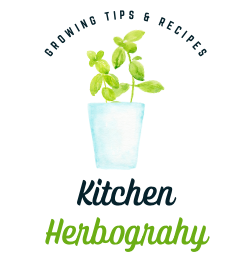As an Amazon Associate I earn from qualifying purchases. This website also participates in other affiliate programs and may earn commissions if you shop through the links used on this website.
(This article was originally published on August 9, 2022 and was last updated on September 3, 2022)
Basil is a relatively easy plant to grow, making it a favorite amongst gardeners (and cooks). Despite its forgiving nature, basil needs a few key things to thrive. One of these is the proper amount of sunlight. But what are basil’s sun requirements? And does basil need full sun to grow? Or can it grow in shade? Keep reading for the answers!
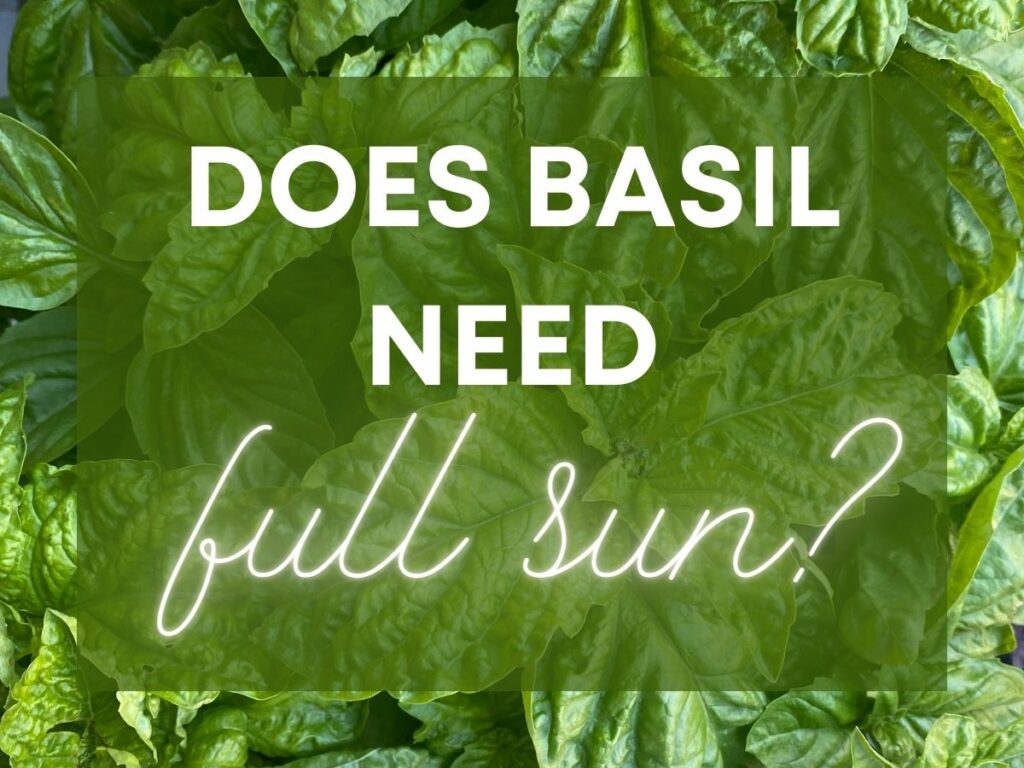
Basil is an annual herb that belongs to the Lamiaceae (mint) family.
Its reputation of being an easy plant to care for is well-earned. You can successfully grow basil in a good sized pot the smallest of kitchens or allow it to take over your garden. And with an estimated 50-150 varieties of basil to choose from, growing your own basil – and all of it’s tastes – can help you take your culinary adventures to a new level.
To help your basil thrive (rather than survive), you want to provide it with proper care.
One of the things basil needs to reach its full potential is access to sunlight. Unlike some other plants, the amount of sunlight basil receives is very important.
So, what kind of sun does basil need? This article explores everything you need to know about basil sun requirements.
Does Basil Need Full Sun?
Yes, growing basil requires full sun. Basil requires 6-8 hours of direct sunlight per day, and will thrive in as many as 12 hours of sunlight daily.
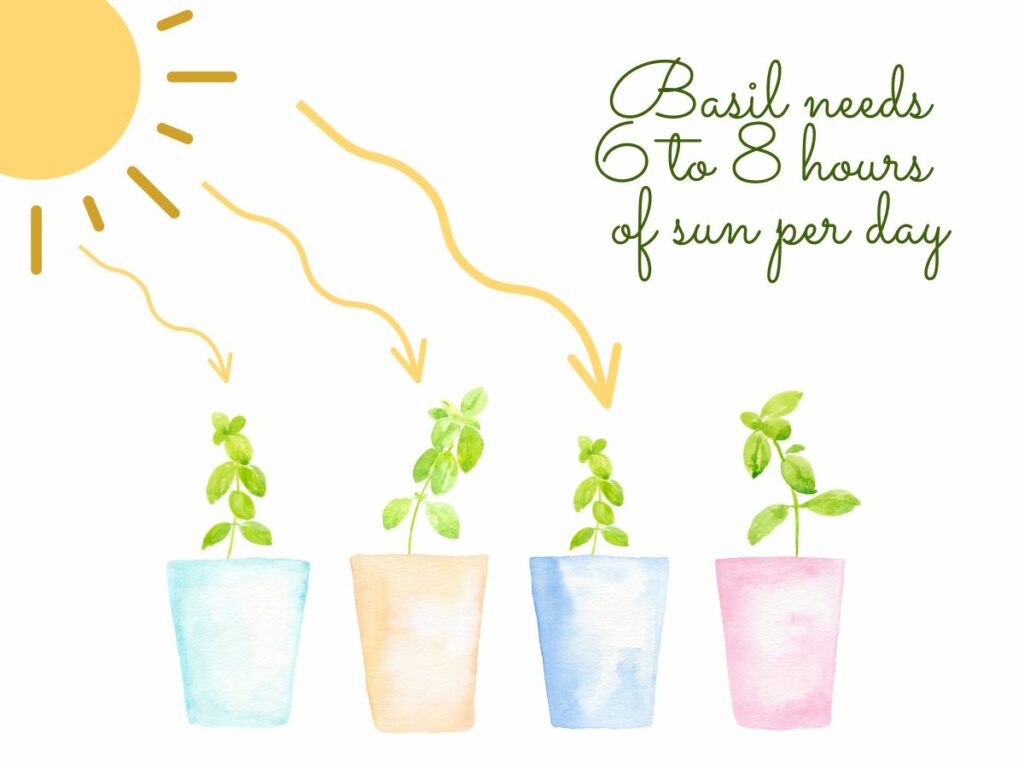
Can Basil Grow in Indirect Sunlight?
Basil loves sunlight, and a basil plant’s leaves get their deep, rich color from the sun. Even purple basil needs lots of sun for its color!

Although basil prefers approximately six to eight hours of sun daily to grow into a large, bushy plants, basil plants can grow in areas that receive mostly indirect sunlight.
For example, you can successfully grow different varieties of basil plants indoors in either containers or aquaponic setups, such as AeroGardens or Click and Grow smart gardens. This is a great set up for the winter! While these are generally super easy, they don’t completely exempt you from common basil problems, such as brown spots on the leaves or holes in the leaves (we have experienced both with growing basil in a Click and Grow). You’ll also still need to stay on top of regular basil care issues, like assertively harvesting the leaves to encourage growth and keeping those basil flowers at bay.
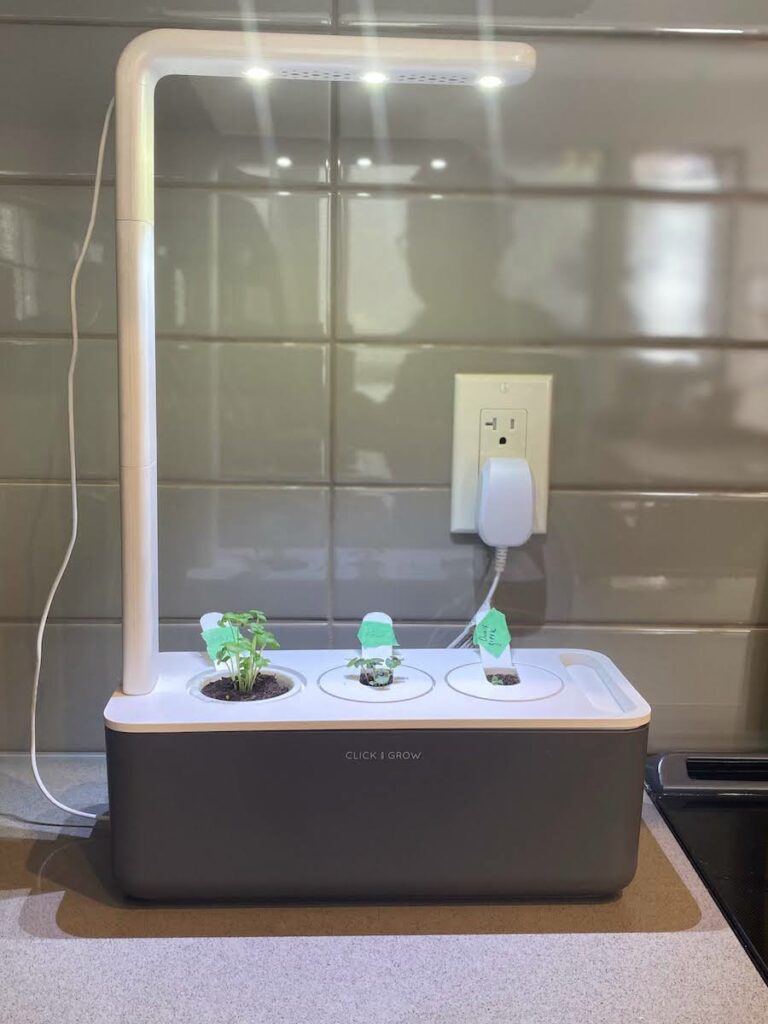
Typically, houses and apartments do not receive enough direct sunlight to create an ideal environment for growing basil indoors. To compensate against this loss, place your basil plants grown indoors in the sunniest area possible to receive maximum light, such as a sunny window ledge. Then add an LED growing light as a supplementary light source if needed.
When you plant basil outdoors, consider placement.
If walls or surrounding buildings block your garden, preventing it from receiving at least six hours of full sun daily, you can likely still successfully grow basil plants. Select the location with the most abundant direct sun in your garden for planting, and try to provide ideal other conditions for the plants. These include watering schedule and soil moisture, warm temperatures, nutrient rich soil, and adequate plant spacing to reduce the risk of diseases that cause your basil to do gross things, like turn black or develop mouldy white spots. While basil is pretty easy to grow, there are also some fairly common problems caused by improper conditions, like plants that turn yellow or extreme wilting.
Can Basil Grow in Shade?
As a frost-tender annual, basil thrives on plenty of sun, fertile soil, and fresh air – healthy growth depends on it.
Basil grows best with consistent and direct sunlight for at least 6 hours each day. That said, there are certain circumstances when basil will grow decently in shade.
Can You Grow Basil in Shade? Full Shade vs Partial Shade
Before exploring whether basil can grow in shade, we need to understand what the term “shade” means.
There are two distinct categories of shade: full shade vs. partial shade.
Full shade is when an area receives 1 hour or less of sun per day. Picture the space beneath a large tree. During a large portion of the day, that area is shaded and does not receive direct sunlight.
Partial shade means an area receives between 2 and 6 hours of sun daily.
This applies to lots of gardens and patios, which receive morning sun and afternoon shade, or vice versa.
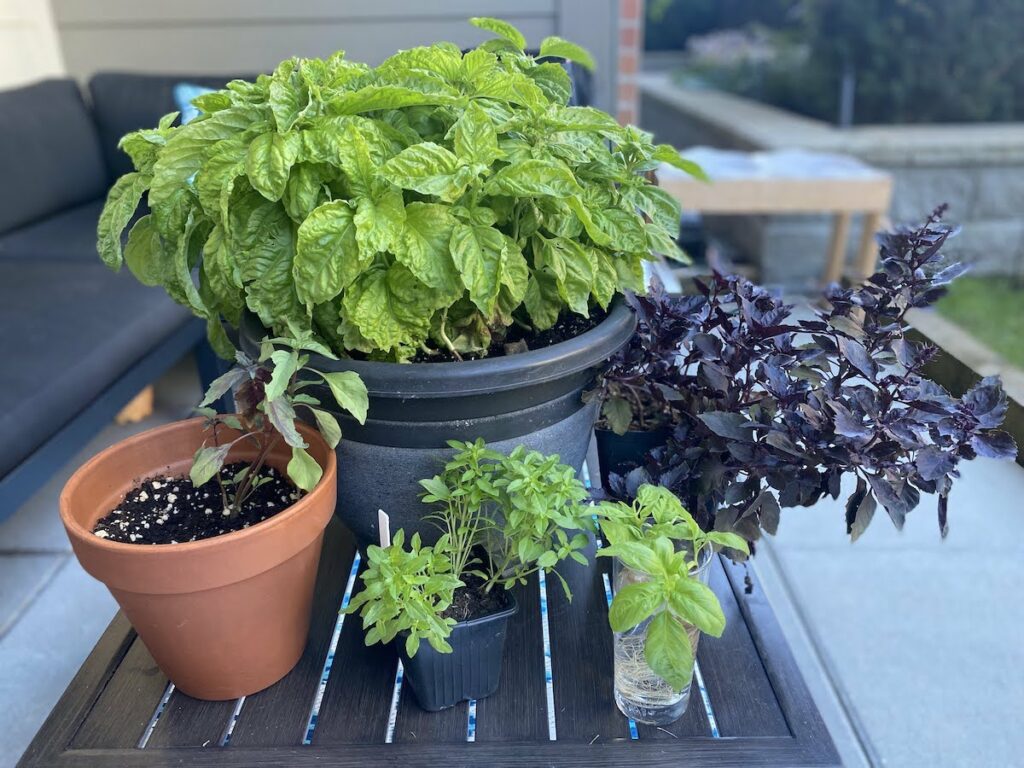
Basil in Full Shade
Basil will not grow in full shade. It relies on direct sunlight to absorb energy and develop those gorgeous green leaves.
Basil planted in full shade will try to fight through the lack of sun for a while. The plant will put more energy into growing tall to reach the sunlight, and transforming into a long, leggy plant with small leaves (even with regular and correct pruning). Instead of developing new leaf shoots which creates a big, bushy and healthy plant with plenty of basil leaves to harvest, a basil plant with inadequate hours of sunlight will grow tall and leggy.
However, eventually your basil plant will die without adequate sunlight.
Basil Plant in Partial Shade / Partial Sun
If you plant basil in an area with partial shade that receives less than 6 hours of sunlight, it will still grow. However, it will not thrive.
For most of us, the goal of growing basil is to get those large, delicious leaves that are the hallmark of healthy basil.
Growing basil in an area with partial sun (less than 6 hours daily) will result in a plant with significantly smaller and not nearly as abundant leaves.
Additionally, basil plants grown in partial shade may be more susceptible to diseases. If they are in partial shade, not receiving enough air circulation, or are getting too much water, you risk downy mildew attacking. Keep your basil’s soil moist but not boggy to prevent excess moisture that will attract unwanted diseases and pests.
The good news is that basil leaves grown in partial shade are still edible. You can harvest basil grown in partial sun to eat fresh or preserve them for future use. Since a lack of sun stunts the growth of basil plants, there won’t be as many leaves to harvest, and the plant may not last the entire growing season.
Can Basil get too Much Sun?
Yes, basil can get too much sun.
In most growing environments, too much sun is not really a problem for basil. It can handle up to 12 hours of direct sunlight each day, and thrives in temperatures up to 90° F, or 32° C.
However, there are two primary areas where excess sun becomes an issue.
The first is in extreme heat, often found in desert environments or in unseasonable heat waves or events. When basil plants are exposed to large amounts of sun in temperatures consistently above 90°F/32°C, the leaves can get scorched in a form of basil sun burn. The leaves will start developing white or yellow spots when they get burned. Ultimately they will become brittle and fall off the plant.
If you know your basil will be exposed to such a harsh environment, select an area in your garden that gets some protection from the beating afternoon sun, or move your basil plants that are potted.
The other thing to pay attention to is the amount of water you provide your basil plants when they are exposed to excess sun. It is more difficult for soil to retain moisture in hot and sunny environments.
If your basil plant is exposed to too much sun and does not receive sufficient water, it will lose too much moisture through transpiration. During transpiration, water evaporates from the leaf’s surface. This evaporation is a natural occurrence and generally is no reason to worry. However, when plants run out of water to pull up from the soil, there is nothing to replace the moisture evaporating directly from the leaves themselves.
In basil plants, the first sign of inadequate watering is drooping leaves. From there, they will start to dry out and may turn yellow. The combination of too much sun and too little water makes basil vulnerable to pest infestation or diseases.
If your basil is getting more than 12 hours of sunlight per day, or is exposed to excess sunlight in particularly high heat, you will want to water more often and consider adding mulch around your basil plants to prevent evaporation.
What Happens to a Basil Plant not Getting Enough Sun?
The prized leaves of basil develop through the process of photosynthesis.
In short, during photosynthesis, plants capture energy from the sun. They combine it with CO2 and H2O, converting those components to oxygen, which gets released back into the air.
During photosynthesis, the sun’s energy gets absorbed by the plant. It is then reflected back out via the pigment chlorophyll.
Without adequate sunlight, chlorophyll cannot do its job, and affected leaves will turn yellow and drop off the plant.
In addition, inadequate sun creates an environment favorable to downy mildew. Often, a lack of sun goes hand in hand with poor air circulation. Without the sun to dry moisture off the leaves or proper airflow to aid in the process, you risk diseases attacking your plants. Downy mildew particularly likes warm, moist environments that are common in areas without adequate sunlight.
Tips for Growing Basil in Partial Shade
If your basil plants are growing in partial shade, pay close attention to the moisture level of your soil. It should remain consistently moist but not saturated or boggy. Looking at the soil’s surface is typically not the best indicator. Water on top may have evaporated while leaving the area underneath plenty moist. If you have questions, stick your finger at least an inch deep. Moist soil beneath the surface means watering can wait for a little longer before watering.
Basil Seeds: Seedlings and Sun Requirements
Basil seedlings have different sunlight requirements, and it’s possible for a basil plant to get too much sun is when it is a seedling.
Pay close attention to the extended forecast if you like to direct sow your basil seeds. Basil seeds take longer to germinate in extreme heat. So try to plan for planting basil after the spring frost, but before the summer heat settles in. If you miss this window, you can always start your basil inside.
Keep in mind seedlings grown inside get used to the cushy and controlled environment. So you will have to harden off your seedlings before transplanting. While this can feel like it will take too much time, your basil seedlings will thank you for your efforts. When basil seedlings get exposed to direct sunlight without this hardening off period, it puts undue strain on the plants. It could stunt their growth or scorch their delicate leaves.
How Much Sun Does Basil Need When Container Gardening?
It is possible to meet the sun requirements for basil if you are container gardening. However, you will want to put extra thought into your growing space. Make sure to put container gardens in the area that gets the most and highest quality of sunlight in your home. A south facing, sunny windowsill is an ideal way to get a minimum of 6 hours of direct light in many climates.
Basil growing indoors – or basil you start growing in water from a cutting – may also require a supplementary light source. Consider installing a grow light if you know you can’t provide 6 hours of direct sunlight. You will want to opt for an LED light and increase the total “sun” time to 10 hours to compensate for the lack of natural light. You can also bring them outside whenever possible to get some direct sunlight.
So…How Much Sun Does Basil Need?
Basil adores a warm, sunny growing environment. Its ideal growing conditions include moist, fertile soil, fresh air, and 6 to 8 hours of direct sunlight. Basil plants will thrive in as much as 12 hours of direct sunlight daily.
If your basil is in a growing environment that does not quite meet this ideal scenario, don’t worry!
Basil is a very forgiving plant that will grow in many suboptimal conditions – it will probably grant you some leeway.
You can easily grow basil indoors or in other areas that do not receive quite enough sun. But keep in mind, basil will not reach its full potential outside its ideal growing conditions.
Jennifer is a writer, Nutritionist, and Herbalist who loves all things food. She grows basil alongside other herbs and edible flowers in her garden. Herbs also hold a prominent space in her aerogarden. She enjoys experimenting in the kitchen, finding fun and unique ways to incorporate herbs into daily life. Jennifer is passionate about helping others discover the joy of quality food. And she loves to bring her two kids along on endless food adventures!
